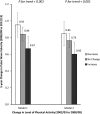Physical Activity, Sedentary Behavior, and Long-Term Changes in Aortic Stiffness: The Whitehall II Study
- PMID: 28784651
- PMCID: PMC5586440
- DOI: 10.1161/JAHA.117.005974
Physical Activity, Sedentary Behavior, and Long-Term Changes in Aortic Stiffness: The Whitehall II Study
Abstract
Background: Physical activity is associated with reduced cardiovascular disease risk, mainly through effects on atherosclerosis. Aortic stiffness may be an alternative mechanism. We examined whether patterns of physical activity and sedentary behavior are associated with rate of aortic stiffening.
Methods and results: Carotid-femoral pulse wave velocity (PWV) was measured twice using applanation tonometry at mean ages 65 (in 2008/2009) and 70 (in 2012/2013) years in the Whitehall-II study (N=5196). Physical activity was self-reported at PWV baseline (2008/2009) and twice before (in 1997/1999 and 2002/2003). Sedentary time was defined as sitting time watching television or at work/commute. Linear mixed models adjusted for metabolic and lifestyle risk factors were used to analyze PWV change. Mean (SD) PWV (m/s) was 8.4 (2.4) at baseline and 9.2 (2.7) at follow-up, representing a 5-year increase of 0.76 m/s (95% CI 0.69, 0.83). A smaller 5-year increase in PWV was observed for each additional hour/week spent in sports activity (-0.02 m/s [95% CI -0.03, -0.001]) or cycling (-0.02 m/s [-0.03, -0.008]). Walking, housework, gardening, or do-it-yourself activities were not significantly associated with aortic stiffening. Each additional hour/week spent sitting was associated with faster PWV progression in models adjusted for physical activity (0.007 m/s [95% CI 0.001, 0.013]). Increasing physical activity over time was associated with a smaller subsequent increase in PWV (-0.16 m/s [-0.32, -0.002]) compared with not changing activity levels.
Conclusions: Higher levels of moderate-to-vigorous physical activity and avoidance of sedentary behavior were each associated with a slower age-related progression of aortic stiffness independent of conventional vascular risk factors.
Keywords: aortic stiffness; physical exercise; pulse wave velocity.
© 2017 The Authors. Published on behalf of the American Heart Association, Inc., by Wiley.
Figures

References
-
- Shiroma EJ, Lee IM. Physical activity and cardiovascular health: lessons learned from epidemiological studies across age, gender, and race/ethnicity. Circulation. 2010;122:743–752. - PubMed
-
- Ahmed HM, Blaha MJ, Nasir K, Rivera JJ, Blumenthal RS. Effects of physical activity on cardiovascular disease. Am J Cardiol. 2012;109:288–295. - PubMed
-
- Ding D, Lawson KD, Kolbe‐Alexander TL, Finkelstein EA, Katzmarzyk PT, van Mechelen W, Pratt M. The economic burden of physical inactivity: a global analysis of major non‐communicable diseases. Lancet. 2016;388:1311–1324. - PubMed
-
- Payne RA, Wilkinson IB, Webb DJ. Arterial stiffness and hypertension: emerging concepts. Hypertension. 2010;55:9–14. - PubMed
-
- Nilsson PM, Khalili P, Franklin SS. Blood pressure and pulse wave velocity as metrics for evaluating pathologic ageing of the cardiovascular system. Blood Press. 2014;23:17–30. - PubMed
MeSH terms
Grants and funding
LinkOut - more resources
Full Text Sources
Other Literature Sources
Medical

